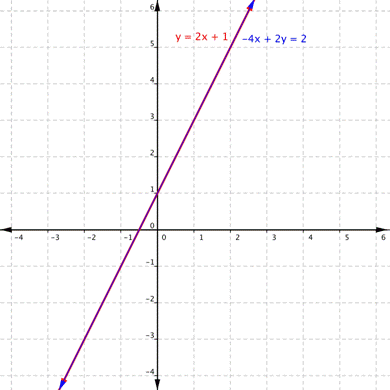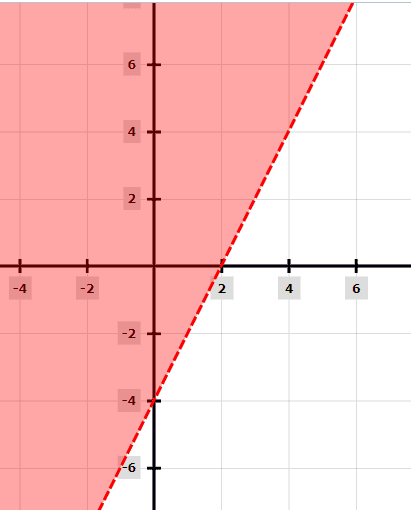How many solutions?

None
What would the system look like after the first step of the substitution method is used?
y + x = 1
x = 1 + y
y + (1 + y) = 1
Show a first step using the elimination method.
y = 2x +5
y = x + 4
y = 2x + 5
y = x + 4
________
0 = x + 1
 When graphing a linear inequality, when would you use a dotted line?
When graphing a linear inequality, when would you use a dotted line?
When the inequality is just less than or greater than.
How many solutions?

Infinitely many
Show the next step after the first substitution is completed:
y = 2x - 1
x + y = 1
x + (2x - 1) = 1
Show a first step in using the elimination method.
2y = 2x - 4
y = 3x - 2
Multiply the second equation by 2.
y = 3x - 2 ==> 2y = 6x - 4
What is the equation of this linear inequality?

y > 2x +1
What is the solution?

(2,2)
Solve using substitution. Show your work!
y = x + 1
x + y = 1
x + (x + 1) = 1
2x + 1 = 1
2x = 0
x = 0
so y = 1
Solve using elimination. Show your work!
x + 2y = 1
x + y = 2
y = -1
x = 3
What is the equation of this linear inequality?
y >= -3x + 4
Would the following system have one, none, or infinite solutions? Why?
y = -2x + 1
y = -2x + 4
None. The lines are parallel because they have the same slope but different y-intercepts.
Solve using substitution. Show your steps!
y = x - 1
y = x - 2
x - 1 = x - 2
-1 = -2
No Solution
Solve using elimination. Show your work!
2y - x = 2
-2y + x = 1
0 = 3
No Solution
What is the graph of the linear inequality:
y < 3x -1
What would the graph of this system look like, and how many solutions would there be?
y = -3x - 4
y = -6/2x - 4
Infinitely many solutions. The equations are the same, so the lines would coincide, or be on top of each other.
Solve using substitution. Show all steps!
y = 2x - 1
y - 10/5x = -1
y = 10/5x -1
y = 2x -1
Both equations are the same, so infinitely many solutions.
Solve using elimination. Show all steps.
3x - 2y = 4
x - y = 1
x = 2
y = 1
Graph the linear inequality:
y > 2x - 4
